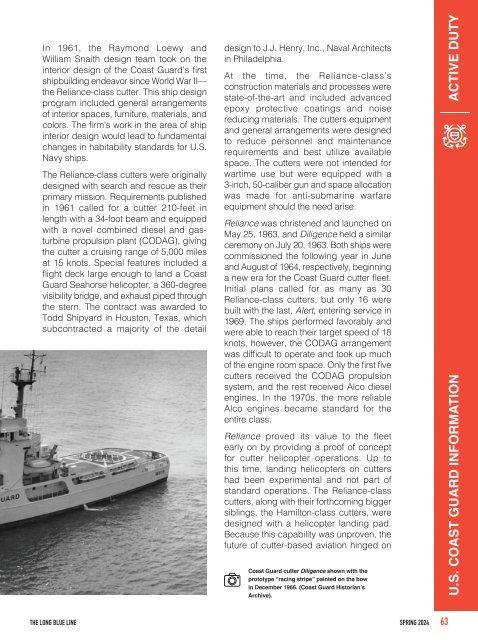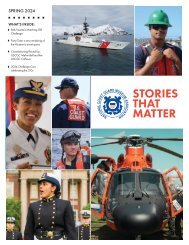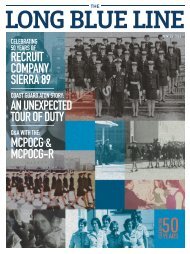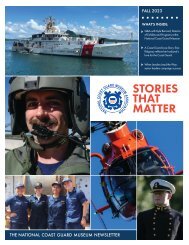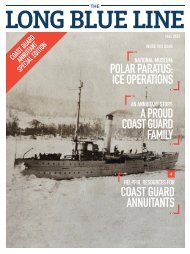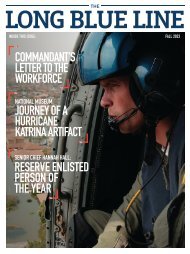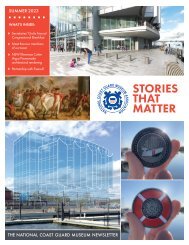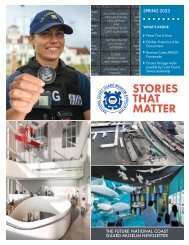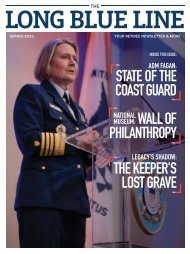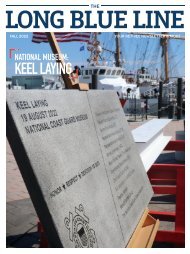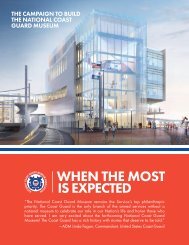The Long Blue Line (Spring 2024)
United States Coast Guard quarterly magazine exploring all things Coast Guard.
United States Coast Guard quarterly magazine exploring all things Coast Guard.
Create successful ePaper yourself
Turn your PDF publications into a flip-book with our unique Google optimized e-Paper software.
In 1961, the Raymond Loewy and<br />
William Snaith design team took on the<br />
interior design of the Coast Guard’s first<br />
shipbuilding endeavor since World War II—<br />
the Reliance-class cutter. This ship design<br />
program included general arrangements<br />
of interior spaces, furniture, materials, and<br />
colors. <strong>The</strong> firm’s work in the area of ship<br />
interior design would lead to fundamental<br />
changes in habitability standards for U.S.<br />
Navy ships.<br />
<strong>The</strong> Reliance-class cutters were originally<br />
designed with search and rescue as their<br />
primary mission. Requirements published<br />
in 1961 called for a cutter 210-feet in<br />
length with a 34-foot beam and equipped<br />
with a novel combined diesel and gasturbine<br />
propulsion plant (CODAG), giving<br />
the cutter a cruising range of 5,000 miles<br />
at 15 knots. Special features included a<br />
flight deck large enough to land a Coast<br />
Guard Seahorse helicopter, a 360-degree<br />
visibility bridge, and exhaust piped through<br />
the stern. <strong>The</strong> contract was awarded to<br />
Todd Shipyard in Houston, Texas, which<br />
subcontracted a majority of the detail<br />
design to J.J. Henry, Inc., Naval Architects<br />
in Philadelphia.<br />
At the time, the Reliance-class’s<br />
construction materials and processes were<br />
state-of-the-art and included advanced<br />
epoxy protective coatings and noise<br />
reducing materials. <strong>The</strong> cutters equipment<br />
and general arrangements were designed<br />
to reduce personnel and maintenance<br />
requirements and best utilize available<br />
space. <strong>The</strong> cutters were not intended for<br />
wartime use but were equipped with a<br />
3-inch, 50-caliber gun and space allocation<br />
was made for anti-submarine warfare<br />
equipment should the need arise.<br />
Reliance was christened and launched on<br />
May 25, 1963, and Diligence held a similar<br />
ceremony on July 20, 1963. Both ships were<br />
commissioned the following year in June<br />
and August of 1964, respectively, beginning<br />
a new era for the Coast Guard cutter fleet.<br />
Initial plans called for as many as 30<br />
Reliance-class cutters, but only 16 were<br />
built with the last, Alert, entering service in<br />
1969. <strong>The</strong> ships performed favorably and<br />
were able to reach their target speed of 18<br />
knots, however, the CODAG arrangement<br />
was difficult to operate and took up much<br />
of the engine room space. Only the first five<br />
cutters received the CODAG propulsion<br />
system, and the rest received Alco diesel<br />
engines. In the 1970s, the more reliable<br />
Alco engines became standard for the<br />
entire class.<br />
Reliance proved its value to the fleet<br />
early on by providing a proof of concept<br />
for cutter helicopter operations. Up to<br />
this time, landing helicopters on cutters<br />
had been experimental and not part of<br />
standard operations. <strong>The</strong> Reliance-class<br />
cutters, along with their forthcoming bigger<br />
siblings, the Hamilton-class cutters, were<br />
designed with a helicopter landing pad.<br />
Because this capability was unproven, the<br />
future of cutter-based aviation hinged on<br />
Coast Guard cutter Diligence shown with the<br />
prototype “racing stripe” painted on the bow<br />
in December 1966. (Coast Guard Historian’s<br />
Archive).<br />
ACTIVE DUTY<br />
U.S. COAST GUARD INFORMATION<br />
THE LONG BLUE LINE SPRING <strong>2024</strong><br />
63


